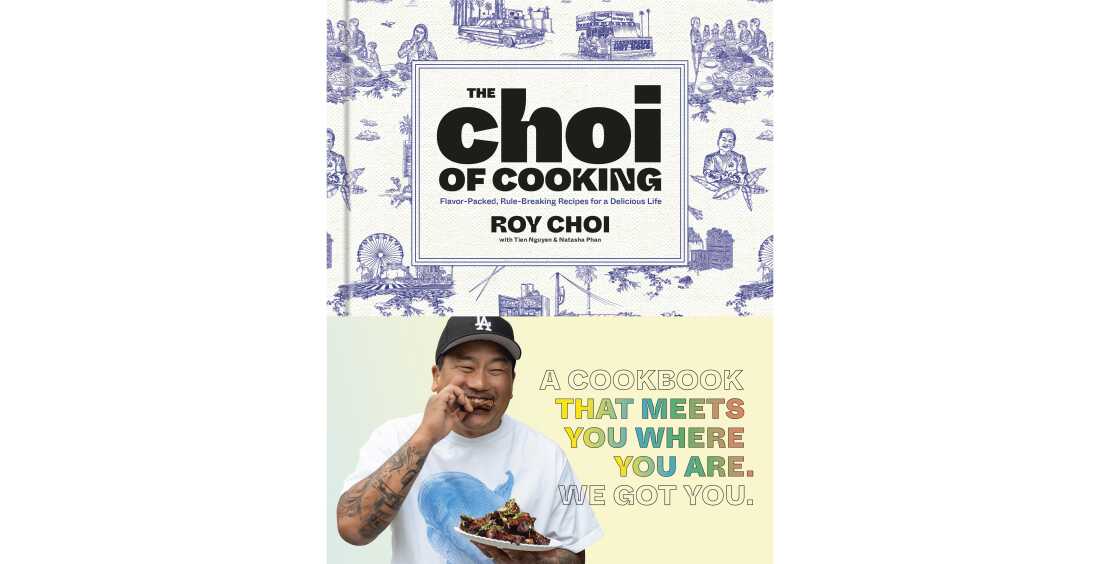
Green bean and chicken stir-fry is one of the many "vegetable-forward" recipes in Roy Choi's cookbook, The Choi of Cooking: Flavor-Packed, Rule-Breaking Recipes for a Delicious Life, which he co-wrote with Tien Nguyen and Natasha Phan. This dish uses the Sweet Garlic Teriyaki Sauce you can find below. Bobby Fisher hide caption
toggle caption
Bobby Fisher
In the late 2000s, chef Roy Choi made his mark by serving up Korean-Mexican fusion street food like short rib tacos and kimchi quesadillas with his Los Angeles-based food truck, Kogi.
Although the name of his business means "meat" in Korean, the ingredient isn't actually the star of the show in his latest cookbook, The Choi of Cooking. The recipes are more reflective of the style of cooking he prefers now: "vegetable-forward with pit stops of comfort along the way," he writes in his book.
"I had been filling my body with fast food and processed food my whole life," he says. "So I had to figure out: How can I make food more delicious, but better for me?"
The Choi of Cooking, co-written with Tien Nguyen and Natasha Phan, is a result of that journey. It features dishes that "satiate you but aren't necessarily sticks of carrots," he says. Think seared tofu with kimchi, roasted cauliflower steaks and a veggie-filled noodle salad with gochujang sauce.
Cooking healthier starts with being confident in the kitchen, he says. Having a good understanding of flavor can help you prepare veggies you'll actually want to eat, and knowing a few culinary tricks — like washing and cutting everything in advance — can make cooking them a little more convenient.

The Choi of Cooking is all about cooking nutritious meals without sacrificing flavor. Clarkson Potter hide caption
toggle caption
Clarkson Potter
In a conversation with Life Kit, Choi, co-host of The Chef Show on Netflix, shares culinary techniques that he has learned in his nearly 30-year career in the restaurant industry. He also shares recipes for three flavorful sauces you'll want to spoon over all your veggies. (Click here to jump to the recipes.)
Prep your veggies like they do in restaurants

Fresh vegetables and aromatics, like ginger, garlic, onions, celery and carrots, are integral to Choi's recipes. Prepping them ahead of time can make it easier to start cooking when you're ready to make dinner. Bobby Fisher hide caption
toggle caption
Bobby Fisher
If you often find yourself buying veggies and then letting them sit uneaten in the fridge, Choi says he has "a hack for exactly that dilemma."
"You have to devote a certain part of your week to prep," he says. "There is no healthy food, no restaurant, without prep."
Wash your produce, cut the items and put them in storage containers like they do in professional kitchens, he says. "Then they become accessible and easy to throw together" when it's time to cook.
Choi likes to precut carrots, celery, onions and fennel. He also peels garlic cloves ahead of time and keeps them ready to go in the fridge. "Mince them or slice them right before you cook so you don't lose any freshness of flavor," he says.
Make homemade sauces and condiments
Another way to make veggies more convenient to cook and more exciting to eat: Whip up your own sauces, pastes and vinaigrettes, Choi says. His cookbook has recipes for flavor bombs like Ginger Ponzu Sauce, Magic Sauce and Sweet Garlic Teriyaki Sauce (click here to jump to the recipes below).
Make these at the start of the week while you're prepping your veggies, he says. Store them in jars, label them and pop them in the fridge, just like they do in restaurants.
These sauces can make veggies more crave-worthy, he says. "If you mix [a] condiment with a bunch of chopped cucumbers and some shredded lettuce, that becomes a meal and it's delicious. You're not really worried about eating chips or candy anymore," he says.
Sauces can also make veggies easier to cook. "These will make it possible for you to quickly round out a meal [or] make a stir-fry on a Tuesday in less than an hour," he writes in his cookbook. Throw some pre-chopped veggies into the oven and spoon a sauce over them, and you've got another meal.
Don't be afraid to use a little MSG
Adding a touch of monosodium glutamate (MSG) is a great way to add restaurant-level flavor to home cooking, Choi says.
For decades, the seasoning was vilified and stigmatized for making people feel ill, a sentiment fueled by anti-Asian racism and xenophobia in America, reports NPR's science podcast, Short Wave. But modern food scientists have found no evidence to support that claim.
As for Choi, the ingredient is his "secret weapon," he says. "It's like a hidden umami," a savory, meaty flavor often found in mushrooms, cheese and tomato sauce.
You've likely encountered the food additive in mayonnaise, ketchup and chips, Choi says. He lists it as an optional ingredient in his cookbook recipes for lemon ranch dressing, shabu-shabu broth and lo mein spaghetti. (A very small portion of people are sensitive to MSG and might want to avoid it.)
So if you'd like to experiment with it, go ahead and add a little MSG. "A little extra never hurts," he writes in his cookbook.
Recipes: 3 flavorful sauces from chef Roy Choi
Recipes from The Choi of Cooking: Flavor-Packed, Rule-Breaking Recipes for a Delicious Life

The Sweet Garlic Teriyaki Sauce, from The Choi of Cooking. Use this sauce for stir-fries, as a glaze for wings and as a marinade, Choi writes in his cookbook. Bobby Fisher hide caption
toggle caption
Bobby Fisher
Sweet Garlic Teriyaki Sauce
Use this sauce for stir-fries, as a glaze for wings and as a marinade, Choi writes in his cookbook.
Makes 3 1/2 cups
1 1/4 cup soy sauce
1/2 cup rice vinegar
1/2 cup orange juice
1/4 cup pineapple juice
2 serrano peppers, coarsely chopped
1/2 cup whole garlic (15 to 20 cloves), sliced
1/2 cup sugar
1/2 medium yellow onion, sliced
1/2 cup chopped scallions
1 teaspoon crushed red pepper flakes
In a medium pot, combine 1 cup water, the soy sauce, rice vinegar, orange juice, pineapple juice, serranos, garlic, sugar, onion, scallions and pepper flakes. Bring to a boil over high heat. Reduce to a simmer. Skim the scum from the surface of the liquid with a spoon. Gently simmer until the garlic softens, about 20 minutes. Remove from the heat. It's ready to use.
To store it, cool it completely, then pour into an airtight container and refrigerate for up to 1 week. You also can freeze this in clean ice cube trays: Cool the sauce completely, then strain and discard the solids, and pour it into the tray. Frozen, it'll keep for 3 months.
Ginger Ponzu Sauce
This sauce keeps for about a week and gets better the longer it sits, Choi writes in his cookbook. It will keep even longer if you remove the ginger and jalapeño. Add those in just before serving.
Makes 1 cup
1/2 cup soy sauce
1/2 cup rice vinegar
Grated zest and juice of 1 lime
1 tablespoon grated fresh ginger
1 jalapeño, thinly sliced
Salt and freshly ground black pepper
In a bowl, combine 1/4 cup water, the soy sauce, vinegar, lime zest, lime juice, ginger and jalapeño. Stir to combine. Season with salt and pepper to taste. It's ready to go.
Magic Sauce
This is Choi's version of his mom's magic sauce, he writes in his cookbook. Spoon it over roast vegetables, or toss it with some rice.
Makes about 3 cups
1 cup gochugaru
1/2 cup gochujang
1/2 cup chopped yellow onion
1/2 cup beef broth or water
6 tablespoons fish sauce
1/4 cup rice vinegar
1/4 cup toasted sesame oil
1 1/2 tablespoons chopped garlic
1 1/2 tablespoons soy sauce
In a blender, combine the gochugaru, gochujang, 1/2 cup water, onion, beef broth, fish sauce, vinegar, sesame oil, garlic and soy sauce. Puree until smooth, then it's ready to use. Keep it in an airtight jar or container and refrigerate; it'll keep for at least a month. Note that right out of the fridge, it may be a little thick; you can add a splash of water to loosen it up before using.
The digital story was edited by Sylvie Douglis and Meghan Keane, with art direction by Beck Harlan. We'd love to hear from you. Leave us a voicemail at 202-216-9823, or email us at [email protected].
Listen to Life Kit on Apple Podcasts and Spotify, and sign up for our newsletter. Follow us on Instagram: @nprlifekit.

 1 month ago
43
1 month ago
43


















































